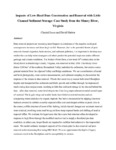| dc.rights.license | In Copyright | en_US |
| dc.creator | Iosso, Chantal | |
| dc.date.accessioned | 2020-10-12T17:11:13Z | |
| dc.date.available | 2020-10-12T17:11:13Z | |
| dc.date.created | 2020 | |
| dc.identifier | WLURG38_Iosso_GEOL_2020 | |
| dc.identifier.uri | http://hdl.handle.net/11021/34927 | |
| dc.description | Thesis; [FULL-TEXT FREELY AVAILABLE ONLINE] | en_US |
| dc.description | Chantal Iosso is a member of the Class of 2020 of Washington and Lee University. | en_US |
| dc.description.abstract | Dam removal projects are becoming more frequent as awareness of the negative ecological consequences increases and dams begin to fail. However, due to the potential threats of post-removal channel migration, bank erosion, and sediment pollution, it is important to develop case studies that can help water managers and others predict the potential responses under different geologic and climate conditions. The Jordan's Point Dam, a low-head 19th-century dam on the Maury River in Rockbridge County, Virginia, was removed in May 2019. The Maury River drains 1280 km2 of the southern Shenandoah Valley underlain by carbonates, but carries coarse-grained material from the adjacent Valley and Ridge sandstones. We use a combination of aerial and bank photography, cross section measurements, and sediment sampling to characterize the response of the stream to dam removal. Floods that occur in any season both raised floodplain heights and transported fine sediments and likely gravels and cobbles through the impounded reach during dam emplacement, resulting in little fine sediment storage in the channel behind the dam. After dam removal, water level drop in the 2-km-long impoundment revealed several types of material. The largely steep and muddy banks have failed in isolated reaches and are compacting where underlain by organic deposits The bed is characterized by dipping limestone bedrock covered by cobbles in newly exposed riffles and sand draped cobbles in pools. Due to the coarse, cobble structure of most of the thalweg, initial channel changes and sediment removal were minimal, involving some mud being cut from steep exposed banks and shifting of sand in exposed riffles. We evaluate the hypotheses that the coarse bed structure either developed in response to high flows through the modified reach or that is simply a fossilized pre-dam condition; in either case, larger floods are required to mobilize bed sediment in the impounded reach. We model sediment transport capacity of the stream prior to dam removal and post-removal under increasing flow using HEC-RAS. We also approximate the depth of legacy sediment stored in the floodplains and its susceptibility to erosion. | en_US |
| dc.description.statementofresponsibility | Chantal Iosso | |
| dc.format.extent | 27 pages | en_US |
| dc.language.iso | en_US | en_US |
| dc.rights | This material is made available for use in research, teaching, and private study, pursuant to U.S. Copyright law. The user assumes full responsibility for any use of the materials, including but not limited to, infringement of copyright and publication rights of reproduced materials. Any materials used should be fully credited with the source. | en_US |
| dc.rights.uri | http://rightsstatements.org/vocab/InC/1.0/ | en_US |
| dc.subject.other | Washington and Lee University -- Honors in Geology | en_US |
| dc.title | Impacts of Low-Head Dam Construction and Removal with Little Channel Sediment Storage: Case Study from the Maury River, Virginia | en_US |
| dc.type | Text | en_US |
| dcterms.isPartOf | RG38 - Student Papers | |
| dc.rights.holder | Iosso, Chantal | |
| dc.subject.fast | Dams -- Environmental aspects | en_US |
| dc.subject.fast | Dam retirement | en_US |
| dc.subject.fast | Virginia -- Maury River | en_US |
| local.department | Geology | en_US |
| local.scholarshiptype | Honors Thesis | en_US |
